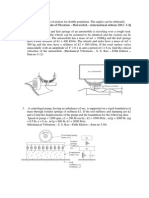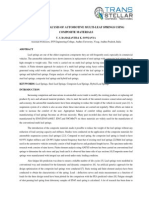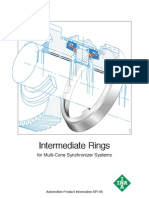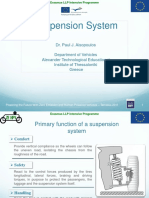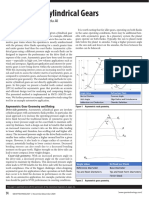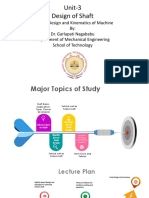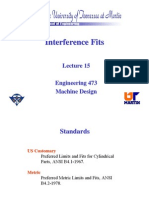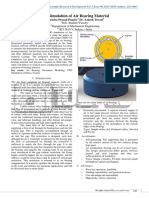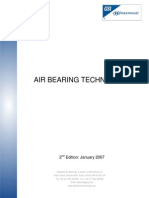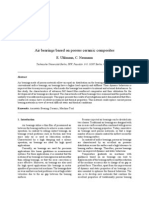Air Bearing 1
Air Bearing 1
Uploaded by
YashOdeepAthawaleCopyright:
Available Formats
Air Bearing 1
Air Bearing 1
Uploaded by
YashOdeepAthawaleOriginal Description:
Copyright
Available Formats
Share this document
Did you find this document useful?
Is this content inappropriate?
Copyright:
Available Formats
Air Bearing 1
Air Bearing 1
Uploaded by
YashOdeepAthawaleCopyright:
Available Formats
STUDY OF AIR BEARING
1.INTRODUCTION
Air bearing are bearings that use a thin film of pressurized air for providing exceedingly low
friction load bearing interface between surfaces. The two surfaces do not touch. As they are
contact free, they provide tradition bearing problems of wear, friction, particulates and
lubrication handling, and offer a distinct advantage in precision positioning, such as lacking
backlash and static friction, as well as in high speed applications. The fluid film of the bearing is
air that flows through the bearing itself to the bearing surface. The design of the air bearing is
such that, although the air constantly escapes from the bearing gap, the pressure between the
faces of the bearing is enough to support the working loads. Thus, there is a differentiation that
has to be made between hydro-dynamical bearings, which establish the air cushion through their
movement, and hydrostatical bearings, in which the pressure is being externally inserted. Air
bearings are being mainly used in precision machinery tools (measuring and processing
machines) and fast running machines (high speed spindle).
FIGURE 1.1: Cross-Section Through Bearing, Fitted With Orifice
1
SYCET, AURANGABAD
STUDY OF AIR BEARING
FIGURE 1.2: Section Through Orifice Line
The basic principle of operation of air bearings has been established for more than fifty years. An air
bearing may comprise of a sleeve separated from a plain shaft by gap, typically 5 50 m. High pressure
air is fed through small orifices in the sleeve through the bearing gap where it flows along the gap and
out of the ends of the bearing. Orifice size is matched to the bearing size so that under no load the
pressure in the gap, just downstream of the orifice, is approximately half the supply pressure. When a
radial load is applied, the gap on one side of the shaft closes down increasing its resistance to and
causing pressure to rise. On the opposite side of the shaft, the larger gap has reduced resistance to
airflow and allows pressure to fall. The pressure difference across the bearing gives it the capacity to
support the applied load without incurring any metal metal contact even if there is no shaft rotation.
SYCET, AURANGABAD
STUDY OF AIR BEARING
2. LITERATURE REVIEW
The bearing capacity of a foundation is defined as the critical load per unit area at either the
ground surface or at a certain depth below the ground surface that is necessary to mobilize the
full shear strength of the soil along some continuous failure surface. The critical load depends
not only on the mechanical properties of the soil but on the size and shape of the footing. The
problem of evaluating the critical static load has been treated by number of researchers, for
examples, Terzaghi, 1943; Meyerhof, 1951; Vesic, 1973, but a mathematically rigorous solution
has been attained only under greatly simplified assumptions.
In comparison with the extensive studies on the static bearing capacity of shallow foundations,
only a limited amount of information is available in literature on the dynamic bearing capacity of
soils. Where the latter information is available, the analyses and experimental investigations deal
essentially with vertical vibrations as in machine foundations. Very little is available in literature
describing studies of the bearing capacity of soils under earthquake type loads.
It was reported in literature that many buildings failed during earthquakes by soil bearing
capacity failure. Most of these failures are ascribed to the liquefaction phenomenon of the soil- a
condition where the mean effective stress in a saturated soil, essentially loose saturated cohesion
less soil, is reduced to zero. For example, during the Niigata, Japan, earthquake of June, 1964,
apartment buildings at Kawagishicho were tilted, some by as much as 60, yet there was almost
complete absence of other (structural) damage. This indicates that the bearing capacity of the soil
was reduced to a very low value.
SYCET, AURANGABAD
STUDY OF AIR BEARING
3. AIR BEARING
Air bearings (also known as aerostatical or aerodynamical bearings) are bearings that use a thin
film of pressurized air to provide an exceedingly low friction load-bearing interface between
surfaces. The two surfaces do not touch. As they are contact-free, air bearings avoid the
traditional bearing-related problems of friction, wear, particulates, and lubricant handling, and
offer distinct advantages in precision positioning, such as lacking backlash and static friction, as
well as in high-speed applications.
The fluid film of the bearing is air that flows through the bearing itself to the bearing surface.
The design of the air bearing is such that, although the air constantly escapes from the bearing
gap, the pressure between the faces of the bearing is enough to support the working loads. Thus,
there is a differentiation that has to be made between Aerodynamical bearings, which establish
the air cushion through their movement, and Aerostatical bearings, in which the pressure is being
externally inserted.
Air bearings are being mainly used in precision machinery tools (measuring and processing
machines) and fast running machines (highspeed spindle).
3.1 TYPES OF AIR BEARINGS
3.1.1. AEROSTATIC:
Externally pressurised: A separate external supply of air is fed under pressure between the two
surfaces being kept apart. It is a continuous flow system where pressurised gas from the source
flows through restrictors into the clearance between the bearing surfaces escaping to the
atmosphere at the outside edges of the bearing. Types: Simple orifice fed, Pocketed orifice, Slot
fed and Porous.
PRINCIPLE
Because aerostatic bearings have a pressurized air source they can maintain an air gap in the
absence of relative motion between the bearing surfaces. Air bearings offer a solution for many
4
SYCET, AURANGABAD
STUDY OF AIR BEARING
high-tech applications where high-performance and high accuracy is required. Aerostatic
bearings require an external Pressurized air source due to which aerostatic bearings are also
known as passive air bearings. High stiffness can be achieved. The aerostatic bearing is able to
support higher load than the aerodynamic bearing, but it requires continuous power supply for
supplying pressurized air. Overall, aerostatic bearings perform well in most aspects such as
having long life, noise-free operations and are free from contamination Since air has a very low
viscosity, the bearing gaps need to be small, of the order of 1-10 m. As the object floats on a
thin layer of air, the friction is extremely small and even zero when stationary.
FIGURE 3.1. Air Supply
Figure.3.1 shows that, how gas at a supply pressure, Ps is admitted into the clearance through a
restricting device, which reduces the supply pressure. The pressure drop is due to the
acceleration of the gas as it expands. The air will flow through the bearing and back to the
atmosphere where the pressure further reduces to atmospheric pressure, Pa. A smaller clearance
will reduce the pressure drop that gives a higher load capacity. It is desirable to achieve an
optimum condition at which a maximum stiffness occurs where the rate of change of load when
divided by the rate of change of clearance is a maximum.
3.1.2. AERODYNAMIC:
Self-generating: The supporting film is generated by the relative motion of the two surfaces
being kept apart. An aerodynamic bearing can be of several types. The design characteristics
SYCET, AURANGABAD
STUDY OF AIR BEARING
differ greatly between journal and axial bearings and they can suffer problems of instability.
Types: Simple cylinders, Tri-lobe, Grooved (axial / herringbone / spiral) and Stepped
PRINCIPLE
Aerodynamic bearings depend on relative motion between the bearing surfaces and usually some
type of spiral grooves to draw the air between the bearing lands. This bearing action is very
similar to hydroplaning in our automobile on a puddle of water at high speed. At a lower speed
our tire would cut through the water to the road. In just this way, aerodynamic bearings require
relative motion between the surfaces, when there is no motion or when the motion is not fast
enough to generate the air film the bearing surfaces will come into contact. Aerodynamic
bearings are often referred to as foil bearings or self-acting bearings. Examples of this type of
bearing include the read-write head flying over a spinning disk, crankshaft journals, camshaft
journals, and thrust bearings for electrical generator turbines.
3.2. USE OF AIR BEARINGS IN ULTRA-PRECISION SPINDLE
Aerostatic bearings have been adapted to develop spindles called ultra-precision aerostatic
spindles. Since most of the ultra-precision machines require precision class spindle with higher
running accuracy, stiffness and good thermal stability. Aerostatic bearings are in greater demand.
Aerostatic bearing gives high rotational accuracy, thermal stability, stiffness and high operating
speeds, compared to other types of bearings. Ultra- precision machines require spindles with
nanometre accuracy in rotation, moderate axial and radial stiffness, and moderate load carrying
capacity.
FIGURE 3.2. Air Bearing Spindle
6
SYCET, AURANGABAD
STUDY OF AIR BEARING
Later various concepts like active air bearings and passive air bearings and others were
developed. Accompanying this, further high precision is demanded for spindles and spindle
supporting bearings that are elements of machine tools. In the present work an attempt has been
made to develop an aerostatic spindle for ultra-precision machine tool which overcomes the
drawbacks present in anti-friction bearing spindle which were used in precision machine tools.
As problems like wear, thermal errors, lubrication problems, bearing failure etc, were
encountered in anti-friction bearings there was a serious research in the field of precision
engineering. Different types of aerostatic bearings are analysed and the best one is selected for
design and further development. Detailed design of axial grooved journal bearings is done and
groove parameters are studied and optimized. Then the concept of using aerostatic bearings was
developed and it received a huge response from all organizations and research centres.
Ultra-precision machines require spindles with nanometre accuracy in rotation, moderate axial,
radial stiffness, and moderate load carrying capacity. Aerostatic bearings have been adapted to
develop this type of spindles called ultra-precision aerostatic spindles. Since most of the ultraprecision machines require precision class spindle with higher running accuracy, stiffness and
good thermal stability, aerostatic bearings are in greater demand. Aerostatic bearing gives high
rotational accuracy, thermal stability, stiffness and high operating speeds, compared to other
types of bearings.
3.3. THE BASIC PRINCIPLE
Air spindles employ two or more cylindrical journal bearings to support radial loads and an
opposed pair of flat, annular thrust bearings to support axial loads. A practical design of air
spindle also has an integral drive motor and means of work holding. In a typical spindle
compressed air enters through a port on the rear face and is fed through drillings to reservoirs
surrounding each journal bearing and reservoirs positioned either side of the thrust bearings.
From the reservoirs, air is fed through rows of orifices into the bearing gaps. Exhaust air from
the ends of the journal bearings, inner and outer edges of the thrust bearings is vented to
atmosphere .Cooling water enters the spindle through a port on the rear face. From here it is
typically ducted along the spindle where it flows through a reservoir surrounding the front
7
SYCET, AURANGABAD
STUDY OF AIR BEARING
bearing. The cooling water is then fed back along the spindle where it passes through a reservoir
surrounding the rear journal bearing before exiting through a port on the spindles rear face.
3.4. CLASSIFICATION OF AEROSTATIC BEARING
There are five basic types of aerostatic bearing geometries as follows: single pad, opposed pad
journal, rotary thrust and conical journal or thrust bearings. It can be classified again as follow:
1. Journals basically cylindrical surfaces.
2. Thrust bearings circular or annular flat surfaces which are designed for rotation
3. Slider bearings flat surfaces of any boundary shape which are designed for obtaining a sliding
motion.
4. Spherical bearings
3.5. MATERIAL SELECTION
In aerostatic spindle it is important to select carefully the materials used for the shaft, bearing
and restrictors. The following considerations should always be considered for the material
selection.
1. Corrosion resistance
2. Machinability
3. Material stability
4 .Thermal conductivity
5. Thermal expansion
For the bearing bush material, lead bronze is best suited. Lead bronze is corrosion resistant, can
be easily machined and easily soldered or brazed so that the pressure tight fixing of the numerous
feed jets is a relatively simple procedure. They are readily suited for use in combination with
austenitic stainless steel body material. The coefficients of thermal expansion are well matched
theory avoiding thermal stress problems and the electrochemical potentials are identical so that
no electro-chemical corrosion can occur. In the process of analytical calculations three
assumptions are made:
1. The film thickness h0 is uniform over the bearing element
2. A one dimensional axial flow is assumed
3. The pressure drops in axial direction.
8
SYCET, AURANGABAD
STUDY OF AIR BEARING
3.6. MATERIALS OF THE AIR BEARING SPINDLE
The blank for a machine tools spindle may be: 1. Rolled stock in the case of spindles having
diameter < 150 mm. 2. Casting in the case of spindles having diameter > 150 mm It should be
kept in mind that if the spindle blank is cut from rolled stock, the cutting must be done by cutting
tools to avoid additional distortion of the material microstructure. In machine tools spindle
design the critical design parameter is not strength but stiffness. If we compare the mechanical
properties of various steels, then their modulus of elasticity should be more or less equal,
although the strength of the alloyed steels can be considerably greater than of mild steel.
Since stiffness is primarily determined by the modulus of elasticity of the material, it may be
concluded that no particular benefit accrues from using costly alloyed steels are required to make
spindles.
3.7. LOAD CAPACITY
The load capacity can be defined as the total load supported by the bearing surfaces. It can be
obtained by integrating the pressure over the whole of the bearing surface.
3.8. STIFFNESS
Stiffness can be defined as the rate of change of load capacity with respect to change in air gap.
Higher stiffness means less compliance. This means there will be small change in air gap
corresponding to large variation in load.
3.9. EFFECT OF ORIFICE DIAMETER
Load and stiffness plots are taken for different size of orifice diameter. The orifice diameter is
varied from 0.1 to 1.0 mm. The other parameters, such as bearing radius, pocket radius, and
supply pressure, were kept constant. Graph 3.1 and 3.2 show the plot of load capacity and
stiffness with respect to the air gap for different values of the orifice diameter.
SYCET, AURANGABAD
STUDY OF AIR BEARING
GRAPH.3.1 Plot Of Load Capacity With Air Gap
GRAPH 3.2 Plot Of Stiffness With Air Gap
The maximum load capacity is same for all values of orifice diameter. However, as the orifice
diameter decreases, the peak value of stiffness increases. At the same time, the corresponding
value of air gap is also decreasing.
10
SYCET, AURANGABAD
STUDY OF AIR BEARING
3.10. EFFECT OF SUPPLY PRESSURE
All bearing parameters were kept constant except the supply pressure. The orifice diameter was
kept at 1.0 mm. The supply pressure was varied from 6 to 10 bars. Graph. 3.3 and 3.4 show the
plot of load capacity and stiffness versus air-gap for different values of the supply pressure,
respectively.
GRAPH 3.3. Load Versus Air Gap Plot For Different Point
11
SYCET, AURANGABAD
STUDY OF AIR BEARING
GRAPH 3.4. Stiffness Versus Air Gap Plot For Different Point
As the supply pressure increases, the maximum load capacity increases. The peak value of
stiffness also increases with the supply pressure.
3.11. EFFECT OF BEARING DIAMETER
The bearing diameter was varied from 30 to 80mm. The other parameters were kept constant.
Graph 3.5 and 3.6 show the plot for load and stiffness for different values of the bearing
diameter, respectively.
12
SYCET, AURANGABAD
STUDY OF AIR BEARING
GRAPH 3.5. Load Plot For Different Bearing Diameter
GRAPH 3.6. Stiffness Plot For Different Bearing Diameter
From the load plot, it was observed that the load capacity increases with the bearing diameter. The peak
value of stiffness also increases with the bearing diameter. From the analysis, it has been observed that
13
SYCET, AURANGABAD
STUDY OF AIR BEARING
the maximum load capacity is mainly decided by the bearing dimensions and supply pressure conditions.
It does not depend on the orifice diameter. However, orifice diameter has greater impact on the
stiffness. As the orifice diameter decreases, the stiffness increases. Stiffness can be also
increased by increasing the supply pressure and the bearing diameter. This shows that smaller
orifice diameter can result into higher stiffness at smaller air-gap.
3.12. DESIGN METHODOLOGY
The basic understanding of air bearing performance was utilised to develop a simple
methodology to help the design and selection process. Design is an iterative process, but the
number of iterations can be minimised by adopting a careful strategy. Based on the load and
stiffness requirements, the bearing dimensions, orifice size, and supply pressure can be suitably
selected using this approach. Optimum air-gap and correspondingly the required pre-loading can
be also obtained.
14
SYCET, AURANGABAD
STUDY OF AIR BEARING
FIGURE 3.3 Strategy For Air Bearing Design
Based on the load and stiffness requirements, the bearing dimensions, orifice size, and supply
pressure can be suitably selected using this approach. Optimum air-gap and correspondingly
the required pre-loading can be also obtained.
15
SYCET, AURANGABAD
STUDY OF AIR BEARING
4. AIR BEARINGS BASED ON CERAMIC COMPOSITES
Air bearings made of porous materials allow an equal air distribution on the bearing surface. In
comparison with conventional orifice bearings, air bearings have a higher load capacity and
stiffness. Their dynamic behaviour is improved due to many micro pores, which make the
bearings less sensitive to internal and external disturbances.
Pressure injected air bearings can be divided into two classes. Traditional air bearings are
designed with one or more orifices and often combined with grooves to improve the bearing
properties. Today, innovative air bearings used porous materials, so that a large number of micro
cannels control the airflow across the entire bearing surface.
In contrast of orifice bearings, porous air bearings are characterised by an excellent air pressure
distribution across the surface and a high tolerance to bearing surface damage. Therefore, porous
bearings have an improved dynamic and static behaviour. Temperature gradients on machines
with guidance based on air bearings can lead to displacements of the bearing surfaces and the
reduction of the machine accuracy due to change of air gap or preload force. Therefore, apart
from the improvement of dynamic and static properties of air bearings, it is also essential to
optimise the thermal behaviour. The aim is to develop new materials that combine the excellent
properties of traditionally porous bearing materials and the thermal properties of ceramics.
The development of porous ceramic composite materials with their excellent thermal and
mechanical properties allow the design of air bearings for the optimisation of high precision and
high speed machines. Motor spindles for precision tool machines required a constant air gap for
steady properties even at highest rotation speeds. Energy dissipation in drives and the air friction
in bearings at high relative velocities lead to thermal displacements. The result is a negative
influence of static and dynamic spindle behaviour. Ceramic bearings reduce the thermal
deformations to a minimum. Therefore, a motor spindle with porous ceramic air bearings was
developed at IWF for the investigation and optimisation of spindle behaviour.
Comparison of orifice and porous bearings in orifice bearings the air is supplied to the bearing
surface through a small number of precisely sized holes. Since bearings with single orifice have a
high pressure gradient between the orifice centre and the bearing boundary, a proper number of
orifices are strategically placed on the bearing surface (see Figure 4.1).
16
SYCET, AURANGABAD
STUDY OF AIR BEARING
FIGURE.4.1 Pressure Distribution On The Bearing Surface For Orifices (A, B) And Porous
Bearings (C)
Porous air bearings enable the supply of air equally across the whole surface of bearing, so that
the air flow can be restricted and damped at the same time. This can be achieved by diffusing the
air through a porous bearing material, so that a uniform pressure in the air gap is generated (also
see Figure 4.1). Compared with orifice bearings, porous bearings have the highest load capacity
and stiffness including high vibration stability. One of the first porous air bearing materials was
carbon graphite [2, 3]. Subsequently, bearings produced design.
Designing with ceramics is more difficult compared with steel, because steel is much more
tolerant to local stress peaks and material flaws. These disadvantages of monolithic ceramic
materials could be overcome by the development of ceramic composites. Such materials are
synthesised from the assembly of two or more components in order to obtain specific material
properties.
17
SYCET, AURANGABAD
STUDY OF AIR BEARING
One of these ceramic composites is CVI-SiC/SiC, which is composed of a silicon carbide (SiC)
fibre reinforcement imbedded in a SiC matrix during the chemical vapour infiltration (CVI). The
three dimensional SiC fibre architecture and the SiC matrix leads to a structure with an open
porosity of 10 % to 15%, which makes it fluid-permeable. The porosity can be modified by
variation of structure geometry and the controlled filling of this structure with SiC. The
geometrical form of the pores is dependent on fibre direction, and lies between 100 m and 300
m for the test pieces. Semi-finished products like tubes and plate of different thicknesses were
manufactured in a pilot plant.
FIGURE.4.2 Fibre Structure Of Porous Composite Sic/Sic
Contrary to conventional monolith ceramics, the reinforcement with continuous fibres from SiC
guarantees an increased tensile strength, fracture toughness and the elastic modulus of ceramic
substantially. The SiC fibres catch the break in case of sub-critical crack growth, so that the main
cause of brittle failure would be eliminated. In contrast to monolith ceramics, pre-stress is not
necessary for components made of CVI-SiC/SiC.
4.1. Pressure Profile In Bearing Gap
Figure 4.3 shows the pressure profile of planar thrust bearing. The measurement was executed
with an air gap of 10 m and a supply pressure of 0.6 MPa. There is a difference between the
18
SYCET, AURANGABAD
STUDY OF AIR BEARING
expected profile of pressure and the measured one. Compared to the curve for an ideal porous
bearing material, real materials have no constant pressure field over the bearing surface.
However, the experimental data showed a curve with a similar trend. An approximate value for
the gap pressure can be specified with 0.55 MPa for parameters stated above. The following
criteria were necessary to achieve this. There must be a high flatness of bearing and guide
surface, a high mounting accuracy of the ceramic plate and the bearing housing, and an optimal
adjusting method for the measurement.
FIGURE 4.3: PRESSURE PROFILE IN GAP OF A PLANAR THRUST BEARING
4.2. Load Capacity Of Planar Bearing
In Graph 4.1, the results of load capacity at several supply pressure are presented. All curves
show a tendentious similar behaviour. With decreasing air gap, an exponential increasing load
capacity is demonstrated. The maximum value lies at 380 N for a supply pressure of 0.6 MPa
and an air gap of 5 m. With increasing bearing gap, the load capacity trended to zero.
19
SYCET, AURANGABAD
STUDY OF AIR BEARING
Graph 4.1: Measured Load Capacity For Several Air Gaps
The bearing gap pressure and the load capacity are proportional to each other with the surface as
proportionality factor. Therefore, the load capacity curves have the same trend as the pressure
curves. In addition, the point of the maximum load capacity change was not reached for small air
gaps and it was not determinable by data extrapolation. Due to different throttle effect with
variation of air gap, the pressure distribution in gap is also changed. During the measurement, it
was identified that it is not possible to realise a constant pressure over the bearing surface (see
also Figure 4.3) even at decreasing of air gap. For this reason, the mathematically maximum
value of load capacity was not achieved.
For the further determination of the optimal operating points, the knowledge of the maximum
load capacities alone is not sufficient. The investigation of the static stiffness of aerostatic
bearing is of decisive importance, because frequent load change arises in real operation. Since
the measured gap pressures do not consider the real pressure distribution in the bearing gap, the
stiffness was determined directly over the change of the load capacity curves. The stiffness
values give an essential statement about the static and dynamic behaviour. It is also possible to
determine the absorption behaviour of aerostatic bearing for different operating conditions.
20
SYCET, AURANGABAD
STUDY OF AIR BEARING
Graph 4.2 shows the stiffness of bearing for the supply pressure of 0.2 MPa to 0.6 MPa for an air
gap up to 60 m. With a supply pressure of 0.6 MPa and an air gap of 5 m, the maximum
stiffness lies approximately at 14 N/m. With increasing supply pressure, the maximum value
displaced in direction of smaller air gaps.
GRAPH 4.2. Stiffness In Relation Of Bearing Gap And Several Supply Pressures
21
SYCET, AURANGABAD
STUDY OF AIR BEARING
5. ADVANTAGES OF USING AIR BEARING
1) GREATER PRECISION
Air bearings provide extreme radial and axial rotational precision. Since there is no
mechanical contact, wear is minimal, ensuring accuracy remains constant over time.
2) INCREASED TOOL LIFE
The use of air bearings means tool life can be greatly extended.
3) IMPROVED SURFACE FINISH
The accurate, repeatable motion given by air bearing spindles gives a superior surface
finish
4) LONG BEARING LIFE
With no mechanical contact and a clean air supply, free from oil and water, bearing life is
dramatically increased.
5) LOW THERMAL GROWTH
Low friction, constant air flow and efficient power transmission result in minimal thermal
growth.
6) LARGE LOAD CAPACITY
Air bearings can support heavy loads, allowing them to be applied to many industrial
machine tool applications
7) REDUCED VIBRATION
Only minimal levels of vibration and audible noise are produced when running an air
bearing spindle.
8) LACK OF MAINTENANCE
Only the very minimum of maintenance is required. A regular check of air supply and
coolant systems is all that is necessary to ensure complete reliability
9) CLEANLINESS
Air is the only lubrication used; therefore air bearing technology is ideal where there
must be no contamination of the work piece or working environment.
10) HIGH SPEED
22
SYCET, AURANGABAD
STUDY OF AIR BEARING
Low shear forces within the air bearing allow extremely high rotational speeds with
minimal loss of power and very low heat generation. Speeds can exceed 300,000 rpm.
FIGURE 5.1 High Speed Application Advantage
23
SYCET, AURANGABAD
STUDY OF AIR BEARING
BEARING SYSTEMS COMPARISION TABLE
TABLE 5.1. Bearing Comparison Table
24
SYCET, AURANGABAD
STUDY OF AIR BEARING
6. DISADVANTAGES
Air bearings only have a few disadvantages. The main challenging issues are the high
geometrical accuracies which are required during manufacture.
Another issue is the supplied pressurized air which has to be clean and dry.
Fundamentally air bearings require some form of power consumption during operation to
supply the high pressure air, unlike mechanical systems which may operate without any
power input (except mechanical forces)
25
SYCET, AURANGABAD
STUDY OF AIR BEARING
7. APPLICATIONS
Air Bearings are used in a variety of applications including: Coordinate Measuring M a c h i n e s ,
Precision
Machine
Tools,
Semiconductor
Wafer
Processing,
Medical
Machines, Optical Lens Production Equipment, Digital Printers, Lithography, Precision
Gauging, Diamond Turning Machines, Materials Testing Machines, Crystal Pulling,
Rotary Tables, Spindles, and Friction Testing.
26
SYCET, AURANGABAD
STUDY OF AIR BEARING
8. FUTURE SCOPE
Future Vehicles can be designed using this technology.
It can be used for semiconductors manufacturing.
It can be used in aerospace application
It can be used in design of machine tools.
High speed machinery.
Escalators can be built using air bearing technology.
High resolution scanning
27
SYCET, AURANGABAD
STUDY OF AIR BEARING
9. CONCLUSION
By stating the above points we can say that air bearing is the perfect alternative for carrying and
transporting.
The forward and inverse kinematics between the rotor displacement and the individual air gaps at
positions round the stator are developed in closed-forms, which are essential for design, dynamic
simulation and control purposes. Along with the pressure-flow relationship as a function of the
rotor position, the paper presents a detailed dynamic model of the air bearing system. The
dynamic performance of the air bearing system has been evaluated analytically by simulation.
28
SYCET, AURANGABAD
STUDY OF AIR BEARING
`REFERENCES
[1] C. Zwyssig, S. D. Round, and J. W. Kollar, An ultrahigh-speed, low power electrical drive
system. IEEE Transactions on Industrial Electronics, 55(2):577-585, 2008.
[2] R. Haberland, J. C. Aurich, G. M. Schueler, J. Engmann, and K. H. Schmidt, High-speed air
bearing spindles for using ultra-small cutting tools in micro-milling and micro-grinding
processes. In Proc. of the 8th euspen International Conference, Zrich, Switzerland, May 2008.
[3] J. Schiffmann and D. Favrat, Experimental investigation of a direct driven radial compressor
for domestic heat pumps International Journal of Refrigeration, doi:10.1016/j.ijrefrig.2009.06.006,
2009.
[4] T. Waumans, On the design of high-speed miniature air bearings: dynamic stability,
optimisation and experimental validation. PhD thesis, Katholieke Universiteit Leuven - Dept.
Mechanical Engineering, 2009.
[5] J. M. Vance, Rotordynamics of Turbomachinery. John Wiley & Sons, New York, 1987.
[6] L. San Andrs and D. Childs, Angled injection - hydrostatic bearings analysis and
comparison to test results. Trans. ASME - Journal of Tribology, 119(1):179187, 1997.
[7] L. Della Pietra, G. Adiletta, The squeeze film damper over four decades of inves
tigations, Part I: Characteristics and operating features. Shock and Vibration Digest, 34(1):326, 2002.
[8] T. Waumans, J. Peirs, F. Al-Bender, and D. Reynaerts, Design, optimisation and testing of a
high-speed aerodynamic journal bearing with a flexible, damped support. in Proc. of the 9th
International Workshop on Micro and Nanotechnology for Power Generation and Energy
Conversion Applications, pp. 83-86, Washington DC, USA, December 2009.
[9] T. Waumans, J. Peirs, F. Al-Bender, and D. Reynaerts, Aerodynamic journal bearing with a
flexible, damped support operating at 7.2 million DN. in Proc. of the 10th International
Workshop on Micro and Nanotechnology for Power Generation and Energy Conversion
Applications, pp. 199-202, Leuven, Belgium, December 2010.
29
SYCET, AURANGABAD
STUDY OF AIR BEARING
30
SYCET, AURANGABAD
You might also like
- The Ackerman Steering PrincipleDocument4 pagesThe Ackerman Steering PrincipleDeb Pradhan100% (1)
- Assignment 2 2dofDocument4 pagesAssignment 2 2dofAnonymous C1A51gvTwNo ratings yet
- BEARINGS: - Bearing Is A Machine Member, Which Supports Moving Parts &Document24 pagesBEARINGS: - Bearing Is A Machine Member, Which Supports Moving Parts &sachinNo ratings yet
- Leaf Spring AnalysisDocument8 pagesLeaf Spring AnalysisDaniel AlvaradoNo ratings yet
- Dynamic Analysis of A Multi-Mesh Helical Gear TrainDocument7 pagesDynamic Analysis of A Multi-Mesh Helical Gear TrainAlexander Jose Chacin NavarroNo ratings yet
- Final Project Report 1Document99 pagesFinal Project Report 1Sikander GirgoukarNo ratings yet
- Drive Shaft - WikipediaDocument5 pagesDrive Shaft - WikipediaMohsen SharifNo ratings yet
- Research Proposal For Axial Compressor BladeDocument18 pagesResearch Proposal For Axial Compressor BladeHein Thiha SanNo ratings yet
- Pneumatic Based Punching MachineDocument45 pagesPneumatic Based Punching Machineraja100% (3)
- CamshaftDocument6 pagesCamshaftcollins arogoNo ratings yet
- Chapter 8: Screws, Fasteners and The Design of Nonpermanent JointsDocument27 pagesChapter 8: Screws, Fasteners and The Design of Nonpermanent JointsSandeep Kumar100% (1)
- Basics of Belt DrivesDocument12 pagesBasics of Belt DrivesSrinivasan Ravi100% (1)
- Double Wishbone SuspensionDocument5 pagesDouble Wishbone SuspensionalexmarieiNo ratings yet
- Parametric Analysis in ANSYS Workbench Using ANSYS FluentDocument48 pagesParametric Analysis in ANSYS Workbench Using ANSYS FluentLok WpNo ratings yet
- Desain Wave Spring WasherDocument7 pagesDesain Wave Spring Washeragung100% (1)
- Multi-Cone Synchronizer SystemsDocument30 pagesMulti-Cone Synchronizer Systemsgrnflash100% (1)
- 2 (B) Design of Knuckle JointDocument16 pages2 (B) Design of Knuckle JointOppo A7No ratings yet
- T3-5 Suspension System PDFDocument20 pagesT3-5 Suspension System PDFGunjan TrivediNo ratings yet
- FE Analysis of Hollow Propeller ShaftDocument2 pagesFE Analysis of Hollow Propeller ShaftJeba ChristoNo ratings yet
- Design and Analysis of Composite Drive ShaftDocument8 pagesDesign and Analysis of Composite Drive Shaftmesfin DemiseNo ratings yet
- Numerical Gerotor DesignDocument18 pagesNumerical Gerotor Designsardhan.rajender84No ratings yet
- Belt DesignDocument56 pagesBelt DesignJade Jazzrel Maglente Aclaro0% (1)
- Axial Fan NotchDocument3 pagesAxial Fan NotchhahasiriusNo ratings yet
- Bearing Materials: Selection Criteria For A Bearing MaterialDocument6 pagesBearing Materials: Selection Criteria For A Bearing MaterialTamirat NemomsaNo ratings yet
- Design and Analysis of IC Engine FinsDocument52 pagesDesign and Analysis of IC Engine FinsShiva KumarNo ratings yet
- Modelling and Analysis 1Document35 pagesModelling and Analysis 1Larry SmithNo ratings yet
- Analysis of PistonDocument8 pagesAnalysis of PistonShahzad ahamadNo ratings yet
- Connecting RodDocument57 pagesConnecting RodNaveenprakash100% (1)
- Project On Spring Testing Machine by Final Mechanical Engineering StudentDocument9 pagesProject On Spring Testing Machine by Final Mechanical Engineering StudentOmkarNo ratings yet
- Composite Leaf SpringDocument23 pagesComposite Leaf SpringVijay AnandNo ratings yet
- Machine Design Project Lecture - 2Document115 pagesMachine Design Project Lecture - 2Hinsermu NeftalemNo ratings yet
- Screw Jack TutorialDocument16 pagesScrew Jack TutorialHareesha N GNo ratings yet
- Air Bearing Design GuideDocument63 pagesAir Bearing Design Guidesamurai7_77No ratings yet
- CFD Simulation of Mixing and Segregation in A Tapered Fluidized BedDocument69 pagesCFD Simulation of Mixing and Segregation in A Tapered Fluidized BedPradeep Kumar KonduruNo ratings yet
- Design of Rocker Bogie MechanismDocument5 pagesDesign of Rocker Bogie MechanismVinoth Rouge RockersNo ratings yet
- A Seminar Report ON Grinding: Submitted by Rajshree B. Tech (Mechanical Engineering) Third Year Roll No: 160180104039Document21 pagesA Seminar Report ON Grinding: Submitted by Rajshree B. Tech (Mechanical Engineering) Third Year Roll No: 160180104039Raj ShreeNo ratings yet
- "Design, Modeling and Analysis of Steam Turbine Blade": Dayananda Sagar College of EngineeringDocument66 pages"Design, Modeling and Analysis of Steam Turbine Blade": Dayananda Sagar College of EngineeringSHREENIVAS MNo ratings yet
- Design and Analysis of Connecting RodDocument3 pagesDesign and Analysis of Connecting RodChandra Sekar50% (2)
- Rolling Element Bearing and Squeeze Film Damper DynamicsDocument14 pagesRolling Element Bearing and Squeeze Film Damper DynamicsRonald George100% (1)
- Solid Ground CuringDocument10 pagesSolid Ground CuringAkshay Hejjaji100% (2)
- Centerless GrindingDocument13 pagesCenterless GrindingrealexplorerNo ratings yet
- Asymmetric Cylindrical GearsDocument6 pagesAsymmetric Cylindrical Gearsकृष्णकुमार दत्तात्रेय जोशीNo ratings yet
- Design of Shaft PDFDocument73 pagesDesign of Shaft PDFDhruv PancholiNo ratings yet
- Theoretical Analysis of Stress and Design of Piston Head Using CATIA & ANSYSDocument10 pagesTheoretical Analysis of Stress and Design of Piston Head Using CATIA & ANSYSinventionjournalsNo ratings yet
- Design Optimization and Analysis of Leaf Spring Using Static Load ConditionsDocument7 pagesDesign Optimization and Analysis of Leaf Spring Using Static Load Conditionshariram palanisamyNo ratings yet
- Gear Box DesigningDocument38 pagesGear Box DesigningAlpesh Panchal67% (3)
- Dynamic Analysis of Leaf SpringDocument9 pagesDynamic Analysis of Leaf SpringTHEBESTNo ratings yet
- Mini Lathe Machine-AbstractDocument5 pagesMini Lathe Machine-AbstractVivace SystmNo ratings yet
- Modal and Stress Analysis of Lower Wishbone Arm Along With TopologyDocument7 pagesModal and Stress Analysis of Lower Wishbone Arm Along With TopologyInternational Journal of Application or Innovation in Engineering & ManagementNo ratings yet
- Interference Fits and PressureDocument21 pagesInterference Fits and PressurerwmingisNo ratings yet
- Sales Rep Locator Call Us at 815-968-3000: Select State Request A QuoteDocument8 pagesSales Rep Locator Call Us at 815-968-3000: Select State Request A QuoteJulio Cesar Aguilar CaceresNo ratings yet
- Leaf SpringDocument15 pagesLeaf SpringAjay SengarNo ratings yet
- Steering PDFDocument79 pagesSteering PDFbroNo ratings yet
- 1design of A Small Wind Turbine For ElectDocument34 pages1design of A Small Wind Turbine For ElectVaibhav SanNo ratings yet
- Air Bearings ReportDocument8 pagesAir Bearings ReportAnurag SrivastavaNo ratings yet
- Seminar PDFDocument21 pagesSeminar PDFArun HbkNo ratings yet
- Rajkiya Engineering College Banda: Air BearingDocument26 pagesRajkiya Engineering College Banda: Air BearingAjay kumar gautamNo ratings yet
- Savitribai Phule University of PuneDocument21 pagesSavitribai Phule University of PunesachinNo ratings yet
- CFD Simulation of Air Bearing MaterialDocument4 pagesCFD Simulation of Air Bearing MaterialkdbbbNo ratings yet
- Air BearingDocument15 pagesAir BearingAnson Dsouza100% (2)
- Seminar Report On Hyperloop OneDocument21 pagesSeminar Report On Hyperloop Oneanirudh singh solankiNo ratings yet
- Air Bearing Design GuideDocument63 pagesAir Bearing Design Guidesamurai7_77No ratings yet
- Mh3d Users ManualDocument102 pagesMh3d Users ManualHimanshu BansalNo ratings yet
- Marform: I Formtester MMQ 150Document28 pagesMarform: I Formtester MMQ 150OSMIR GARCIANo ratings yet
- Air Castor MLS EnybildDocument2 pagesAir Castor MLS EnybildPajserchinaNo ratings yet
- Introduction To Mechanical Micro Machining Assignment-Week 8Document7 pagesIntroduction To Mechanical Micro Machining Assignment-Week 8PranjalGuptaNo ratings yet
- Report of The Seminar-1Document6 pagesReport of The Seminar-1YashOdeepAthawale0% (1)
- Advances in Precision Motion Control: White PaperDocument13 pagesAdvances in Precision Motion Control: White PaperGreen LemonNo ratings yet
- CFD Simulation of Air Bearing MaterialDocument4 pagesCFD Simulation of Air Bearing MaterialkdbbbNo ratings yet
- Hyperloop ReportDocument15 pagesHyperloop ReportshamilNo ratings yet
- Formline en 10037927Document20 pagesFormline en 10037927sreenam225254No ratings yet
- Air Bearing Technology: 2 Edition: January 2007Document17 pagesAir Bearing Technology: 2 Edition: January 2007Jorge CuauhtemocNo ratings yet
- Air Bearing and Its StabilityDocument3 pagesAir Bearing and Its StabilityIJEMR JournalNo ratings yet
- Air BearingsDocument13 pagesAir BearingsRohith RavindranathNo ratings yet
- Air Bearings ReportDocument8 pagesAir Bearings ReportAnurag SrivastavaNo ratings yet
- Seminar Report: ON Hyperloop High Speed Transportation Appu RajappanDocument23 pagesSeminar Report: ON Hyperloop High Speed Transportation Appu RajappanappuNo ratings yet
- Air Bearing: Appendix 1Document45 pagesAir Bearing: Appendix 1Yogesh TheCyaNo ratings yet
- Turbo Submittal At200-0.8s g5p CargillDocument231 pagesTurbo Submittal At200-0.8s g5p Cargillivantellez-famNo ratings yet
- Hyperloop Seminar ReportDocument31 pagesHyperloop Seminar ReportshrutikaNo ratings yet
- Airostatic BearingDocument6 pagesAirostatic BearingJayachandran SenguttuvanNo ratings yet
- Flat Voice Coil ActuatorsDocument12 pagesFlat Voice Coil ActuatorspoorianaNo ratings yet
- Hyperloop Report PDF Seminar ReportDocument21 pagesHyperloop Report PDF Seminar ReportSaurabhNo ratings yet
- Hyperloop Technology: Seminar OnDocument24 pagesHyperloop Technology: Seminar OnAditya ThokalNo ratings yet
- 350FG BrochureDocument1 page350FG BrochureFrida MirelesNo ratings yet
- MARS RheometerDocument24 pagesMARS RheometerJuan Yana MangoNo ratings yet
- Ca0312a Test Measurement WebDocument72 pagesCa0312a Test Measurement WebJohn Melanathy IINo ratings yet
- Ultra Micro Gas Turbine Generator: 1. IntroductionDocument6 pagesUltra Micro Gas Turbine Generator: 1. Introductionhariprasadr5199No ratings yet
- Air Bearing 1Document30 pagesAir Bearing 1YashOdeepAthawaleNo ratings yet
- Seminar PDFDocument21 pagesSeminar PDFArun HbkNo ratings yet
- APG-Neuros Brochure EnglishDocument12 pagesAPG-Neuros Brochure EnglishkrustyboxNo ratings yet

